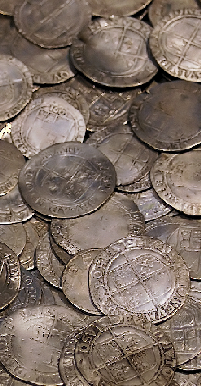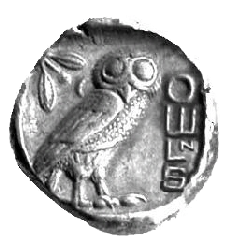
● Next Meeting Status:
Cancelled



● Host Society for the
BANS 2011 Congress
held in Southport


Coins and Tokens of Lancashire
The Circulating Medium Through The Centuries
Throughout the ages there has usually been a shortage of small change. Kings and Princes, Governments and Authorities concentrated on providing prestigious coinages of gold and silver, because these were the kinds of money which the established orders of society needed. For the majority of the people, however, low denominations were wanted: the pennies, halfpennies and farthings which made up the bulk of day to day transactions. Finding small change was not always easy or straightforward though, especially when that small change was made from tiny pieces of silver. It wasn't until the 17th century that mere copper was turned into coin.

Money For England, But Not Made In Lancashire!
In Saxon times there was an almost complete absence of minting of any kind in the
North West of England, with the honourable exception of Chester, despite there being
at least eighty-
Many of the Indentures issued to the mints during the Middle Ages specified that certain proportions of silver farthings and halfpence should be struck alongside the pence, half groats and groats, but these were never enough. The moneyers disliked striking the tiny coins, and they were nowhere near as profitable to make as their larger cousins. The public disliked using them because they were so small and easily lost. The silver farthing, already rare, was discontinued during the reign of King Henry VIII, and not replaced by any official coinage until the copper farthings of King James I.
The last silver halfpennies weighed just over 3 grains, or about 0.2 grammes, were no more than 10mm in diameter, and were discontinued under the Commonwealth. They were not replaced until copper halfpence were issued in the 1670s.
All of these coins were coins for England, though, and although the status of County Palatine gave Lancashire a considerable degree of legal and political autonomy, this never extended to any kind of distinctively Lancastrian coinage. Until, that is, the seventeenth century...

A combination of rising prices, an inadequate supply of official farthings, and an
almost total absence of small silver money, led to an explosion of private tokens,
issued in the 1650s and 1660s. For the first time, but not the last, private individuals
made up for the neglect of central government. And it is during this first great
token-
Of course, the largest numbers of tokens came from the towns and cities. There are fifteen issues recorded for Manchester, twelve from Liverpool, seventeen from Warrington and nine from Preston. But the tokens were essentially democratic, and there are issues recorded from Crosby, Garstang, Huyton, Prescot, Tarleton and Wigan, with no fewer than six from Ormskirk.
Mostly, tokens of the 17th century were small, rather thin, discs of copper, stamped crudely with the name and address of the issuer, and the nominal value.
Many tokens carried a simple graphic image, which related to the business or premises of the issuer. Often, these showed his 'tools of the trade.'
Seventeenth century tokens seldom circulated far from home, and judging by the scarcity of many of the issues today, were effectively called in, or lost, when adequate supplies of official small change arrived, starting in 1672.
For a time the Royal coinage met the need. There were experiments, for example when,
between 1684 and 1692, to stimulate the Cornish Mining Industry, halfpennies and
farthings were made from tin -

The Eighteenth Century -
By the beginning of the eighteenth century copper was well and truly established as the every day money of the poor. As the century progressed, new coppers were struck less and less often, until by 1775 production entirely ceased, just as the Industrial Revolution, and the rise of cash wages, put an increased demand on the copper coinage.
A survey by the Royal Mint in 1787 found that more than 90% of the coppers in circulation
consisted of forgeries and evasions -
Precisely when is unclear. The best estimate is somewhere between the end of 1783 and around 1785. Where is quite clear. The 18th century answer to the cash shortage began at the cotton mill of Colonel Charles Mordaunt, in Halsall, near Southport.
There is a possibility that the dies for this issue were made by Matthew Boulton, but nothing is known for certain. By 1791, Colonel Mordaunt's pennies were reported as being no longer found in circulation in Liverpool. They had been supplanted by the Druid coins issued by the Parys Mine Company of Anglesey, and the Liverpool tokens of Thomas Clarke.
The County Town of Lancaster has been represented by one penny and two halfpenny
tokens. The first of the halfpenny tokens was issued in 1791, and shows a rather
gaunt (!) looking portrait of John of Gaunt, Duke of Lancaster. The reverse featured
the arms of the City of Lancaster, which takes elements form the Royal Arms of both
England and France -
The tokens were extensively counterfeited, and these copies continued, with various dates, up to 1794. The originals were payable at the warehouse of Thomas Worwick and Sons. Worwick was a banker, goldsmith and silversmith, and his premises were in New Street.
The second of the Lancaster tokens was issued for one of the 18th century's genuine
eccentrics. Daniel Eccleston had been involved in maritime trade, before become a
land-
Boulton never received the £57.2s.6d. he was owed for producing the tokens, having to be satisfied with 'half a doz. cocoanuts, very good ones.'
The penny token was issued in 1794 by A Seward, and is a very handsome piece showing
the main gate to Lancaster Castle on the obverse, and a side view of Lancaster Bridge
on the reverse. The only problem with this particular token is that it is very rare,
and seldom found! As it was not only struck in copper but also in brass and white
metal, there would seem to be a good chance that it is a so-

The Eighteenth Century -
Starting in 1791, a very large series of halfpenny tokens was issued in Liverpool,
showing in the edge marking that they were 'Payable at the warehouse of Thomas Clarke'
and featuring two characteristic images of the great port city: a shield of arms
containing a Liver Bird -
Not to be left out, the citizens of Manchester also turned to this alternative form of making money. From 1792, halfpennies were issued by 'I. Fielding' featuring a fine representation of the Grocers' Arms on the obverse.
The reverse showed a detailed view of the East India House, possibly to convey the idea that exotic products were now easily available.
For the following year, 1793, the East India House was replaced by a reproduction of the balemark used by the East India Company to identify its various cargoes. The issuer was now more fully identified as 'IN. FIELDING, GROCER & TEA DEALER'
Click to go directly to your chosen chapter
Money For England
The 17th Century
The 18th Century
Halsall & Lancaster
The 18th Century
Liverpool, Manchester & Rochdale
The Nineteenth Century
Acknowledgements

Where to next?

The tokens of the late eighteenth century were swept away by the torrent of official copper which came from Matthew Boulton's Soho Mint in Birmingham, starting in 1797 with the cartwheel pennies and twopences. Halfpennies and farthings appeared in 1799, and the full house of penny, halfpenny and farthing followed in 1806 and again in 1807. But in the absence of a developed banking system, traders who built up large stocks of copper had no means of disposing of it, otherwise than in trade (if they could find anyone to take it) or as scrap metal. Similarly, traders lacking copper to make change or pay wages could not draw this from a bank or post office, as we might, but had to order it from Boulton, or any wholesaler who could be found. The imbalances in the system, and the extensive melting of coins after 1807 as the price of copper rose under war conditions, led to yet another shortage.
Throughout the country, a third round of token issuing got underway in 1811, though on this occasion the duration and pattern were different. Most issues were over by 1813, and the majority of tokens were issued by industrial concerns, rather than by individuals or small traders.
Lancashire was only thinly represented in this third wave, possibly because it had been one of the principal target areas for delivery of Boulton's copper!
One of the characteristics of the nineteenth century token issues was the inclusion of silver. Sixpenny and shilling tokens appeared from many towns and cities across the country, but it seems that only three of these came from Lancashire.
Thomas Wilson and Company of Liverpool issued a shilling; an unknown issuer provided Manchester with a shilling marked 'for public accommodation' and R D Hall put Poulton on the numismatic map with another shilling.
But rather surprisingly for the County which had invented the copper penny, none of the floods of new copper penny tokens which appeared around the country came from Lancashire.

We would like to thank Dr Keith Sugden, Curator of Numismatics, Manchester Museum, who generously arranged for the photography and provided the illustrations, of the seventeenth century Ormskirk tokens.
We would also like to thank Dr Gary Sriro, of Villa Park, California [gsriro(at)sbcglobal.net] for his kind permission to use the illustrations of the Westwood Half Halfpennies, and Rochdale DH145, from his CD 'Conder Token Scans'
Hover your cursor to
see greater detail

Silver Halfpenny of the
Commonwealth of England 1649-
The last silver halfpennies


Copper Penny Token of Henry Atherton, Ormskirk, 1671


Copper Halfpenny Token of Henry Torbocke, Ormskirk, 1666
Copper Halfpenny Token of Joshua Crosbie, Ormskirk, 1668


Copper Halfpenny Token of Thomas Farrer, Ormskirk, 1666




Copper Penny Token issued for Colonel Charles Lewis Mordaunt of Halsall Mill, Dalton & Hamer Lancashire 1

Copper Halfpenny Token, Lancaster, Dalton & Hamer Lancashire 29a


Copper Halfpenny Token for Daniel Eccleston of Lancaster, 1794
Dalton & Hamer Lancashire 58


White Metal Penny Token of Lancaster, for A Seward, 1794
Dalton & Hamer Lancashire 3

Contemporary Copy of halfpenny token for Thomas Clarke of Liverpool
Dalton & Hamer Lancashire 108d


Halfpenny token for John Fielding of Manchester
Dalton & Hamer Lancashire 127


Halfpenny token for John Fielding of Manchester
Dalton & Hamer Lancashire 127



A second series of Manchester pieces showed a porter, bowed down with the weight of a bale, presumably of cotton, while the obverse featured the arms of the Duke of Bridgewater, with the legend 'SUCCESS TO NAVIGATION' a reference to the recently completed Bridgewater Canal, the second artificial waterway in the country (the Sankey Brook Navigation was the first) which ran from the Duke's collieries at Worsley to Manchester. Once again, the issuer was shown on the edge mark as I Fielding.
Although the name is consistently shown spelled with an 'I' this was no more than
the contemporary, rather archaic, fashion for replacing the relatively recently invented
letter 'J' -
There is a third Manchester halfpenny, one which is rated as 'scarce' which was ostensibly issued by J Rayner and Co in 1793. The obverse of this token shows a left facing portrait of Frederick, Duke of York, and the reverse shows a well engraved rendering (!) of the Bricklayers' Arms. Nothing is known, however, of J Rayner, and these tokens may have been issued anonymously, for profit.
The economic and political centres of Lancashire didn't have a monopoly on private coinage, however, as John Kershaw, Mercer and Draper of Rochdale, proved with his own halfpenny tokens. The first of these was produced in 1791 and features an unusual reverse: a representation of a man weaving at at loom, shown from the back.
The obverse of the token bears the date, and origin, expressed simply as ROCHDALE. This type was repeated in 1792, though it is likely that tokens with this date are contemporary copies produced by John Westwood, token manufacturer, of Birmingham.
Genuine tokens of a more conventional design were introduced by Kershaw, also dated 1792. They show a man seated in a frame, weaving, with the Clothworkers' Arms in a shield on the obverse.
The John of Gaunt type from Lancaster, the Liverpool sailing ship, and the Rochdale weaver were all repeated in a smaller format to produce the rather quaintly named half halfpence, or farthings.
But rather than being genuinely circulating tokens, they were all produced by John Westwood, for sale to collectors.
Halfpenny token for John Fielding of Manchester
Dalton & Hamer Lancashire 135


Halfpenny token for J Rayner & Co
of Manchester, possibly spurious
Dalton & Hamer Lancashire 138


Halfpenny token for John Kershaw
of Rochdale, 1791
Dalton & Hamer Lancashire 140


Halfpenny token for John Kershaw
of Rochdale, 1792
Dalton & Hamer Lancashire 145


Half Halfpenny by Westwood
Dalton & Hamer Lancashire 153
Half Halfpenny by Westwood
Dalton & Hamer Lancashire 156



A Manchester Shilling Token
‘For Public Accommodation’
Issued by an unknown issuer

‘Lancashire One Shilling Token’
Issued by Thomas Wilson & Co
of Liverpool


